-
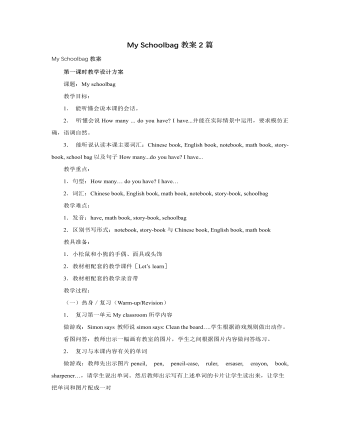
人教版新课标PEP小学英语四年级上册My Schoolbag教案2篇
教师问:Can you spell these words? 如有学生能够拼出单词,教师要给与表扬并说:那让我们来看一看他拼的对不对,然后出示单词卡。如没有学生拼出单词,教师说:我们学习单词不仅要会说还要会写,今天我们就来学习几个单词的拼写,看谁学得快。然后出示单词卡。 让学生看单词卡拼读单词。 教师让学生看单词回答:How many letters in this word?学生回答后,让他们背着拼出单词。 教师让学生在四线三格中默写字母b, o, k, r, l, e, p, n, c, I, a,教师教学生在四线三格中书写单词。告诉学生首先要把每个字母书写正确,然后按照单词的拼写把字母写在一起,注意单词的每个字母间要有一点距离。教师在教写ruler和pencil-case时, 注意小写u和s还没有学习书写,让学生照着板书写就可以了。 让学生照板书抄字头,然后每个单词写一行。 (三)趣味操练(Practice)
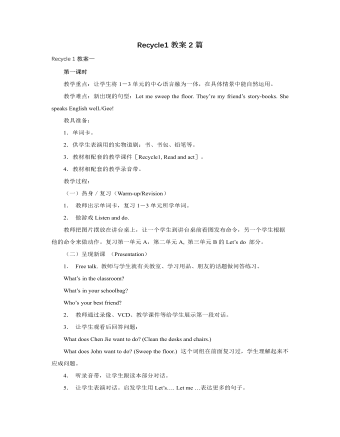
人教版新课标PEP小学英语四年级上册Recycle1教案2篇
Part two1. Teaching AimsMaster the 26 letters.Master the pronunciation of the letters.2. Teaching Aidsa tape-recorder, some cards, some papers and so on.3. Important pointsThe pronunciation of the letters4. Teaching steps1) Greetings and revisionLet some groups act out the dialogue in the last lesson.2) New contentsLet them say out the 26 letters and let some ones say them out.Then listen and learn the letters song.First, give them some minutes and let them read the letters. Let’s see whether there is anyone who can learn anything in them. Then give them some information and let them read again. At last, give them the answer and read again.Let them remember it.PracticeShow the cards where are written the math patterns and let some answer it. Then ask “Who can read it in English?” Let some one read it. Others follow him.Next, show the cards and ask others answer them. T asks and S answers. Then S asks and S answers. Practice in pairs.HomeworkMaster the letters.Teaching notesPart three1. Teaching AimsIntroduce self and others using the words and phrases.Let’s play.2. Teaching Aidsa tape-recorder, some cards3. Important pointsShe has…She likes…I have…4. Teaching stepsGreetings and revisionLet some one read the letters and divide them by the pronunciations.
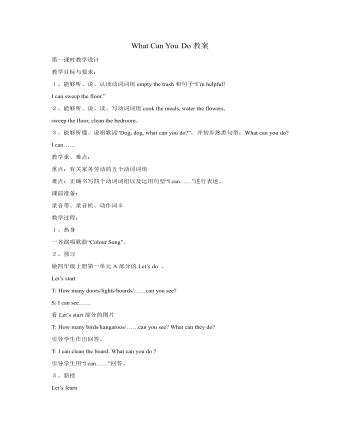
人教版新课标PEP小学英语五年级上册What Can You Do教案
1、能够听懂、会说:Can you ……?Yes, I can./No, I can’t, but I’d like to have a try!并能在情景中运用。2、能够完成Task time中的任务。教学重、难点:重点:Can you ……? Yes, I can./No, I can’t.难点:I’d like to have a try. 以及在实际情景中正确运用所学对话。课前准备:录音带、录音机、动作词卡教学过程:1、 热身(1) 放歌谣,学生边说边做相应的动作。(2) 将动词编入歌谣,有节奏地说唱。2、 预习(1) 听数字,报词组。(2) 做“少了什么?”游戏。(3) 学生拼读四会词组并仿写。3、 新授Let’s try(1)教师向学生展示挂图,放录音,学生用彩笔连线,完成练习。录音内容如下:①Boy: I can make the bed. I can do the dishes. And I can empty the trash.②Girl: I can sweep the floor. I can cook the meals. I can wash the clothes.Listen and link. Who are they?(2)教师检查并指导学生完成连线。(3)师生、生生问答操练:Can you ……?Yes, I can. /No, I can’t.Let’s talk(1)教师放录音,学生跟读。注意“but I’d like to have a try!”的发音和意思。(2)学生四人小组进行对话操练,然后上台表演对话。(3)请若干女生上台,做连锁问答游戏。
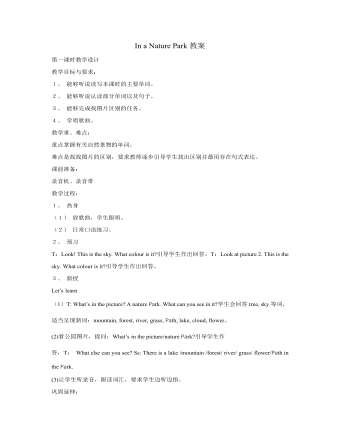
人教版新课标PEP小学英语五年级上册In a Nature Park教案
(3) 听录音,跟读。(4) 同桌之间,进行对话替换操练,然后先几组在班上说一说。(5) 听Let’s check.教师放录音。录音原文如下:Is there a lake in the nature Park?No, there is a river. The water is very clean.Are there any tall buildings in your village?No, there aren’t. There are only small houses.Is there a forest near your village? Yes, there is. There are many beautiful trees. Are there any bridges over the river? Yes, there are two bridges.巩固延伸:做配套练习;做“你猜我答”游戏;做Task time任务第六课时教学设计教学目标与要求:1、 能够听说读写本课句型及单词。2、 能用“There be…”句型介绍山村并描述其特征。教学重、难点:重点掌握句型的书写难点:单词的复数。课前准备:词卡、录音机、录音带教学过程:1、 热身(1) 日常口语练习。(2) 放录音,让学生跟着录音说唱。2、 预习做“拼单词”游戏。3、 新授Read and write(1) 看图,说:There are two pictures. What’s in the pictures? Listen.教师放录音,学生边听边阅读。(2) 学生就不懂的地方提问,教师解答。(3) 放录音,然后指导学生完成练习。(4) 指导学生书写四会句子。
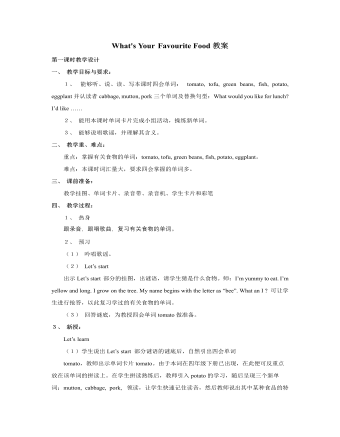
人教版新课标PEP小学英语五年级上册What's Your Favourite Food教案
教读句子:What’s your favourite food?(2)两人小组用该句型编一小段对话进行操练,同时也可引导学生用该句型编一小段对话进行操练,同时也可引导学生用fruit and drink替换food.(3)听录音,让学生跟读对话。学生可用不同的食物单词做替换回答问句。Pair work让学生拿出已发的调查表格,用所学句型对不同学生进行调查,并要求对方陈述原因。先组内汇报,再向全班汇报,汇报时要说出:I like …… Mike likes…… We like……教师看哪一小组表现好,适当给予奖励。Task time请学生拿出第一课时所做的谜语卡片,向全班展示。巩固延伸:做配套练习,读对话给家长听,熟记单词第六课时教学设计教学目标与要求:1、能够听、说、读、写本课时四会句子:What’s your favourite fruit?I like apples. They’re sweet. I don’t like grapes. They’re sour.并能在情景中正确运用。能够在Group work中使用该句型完成调查。2、能够理解情景对话的含义并完成句子填空。3、能够理解Pronunciation中字母组合的发音规则,读出相关的单词。
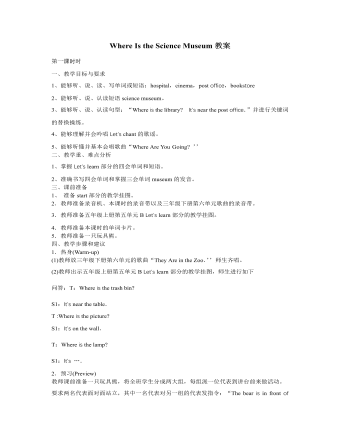
人教版新课标PEP小学英语六年级上册Where Is the Science Museum教案
3.新课呈现(Presentation) (1)教师将Let’s talk部分的教学挂图贴在黑板上说“1 want t0 go to the post office。。 Where is the post office? ”引导学生回答:“It’s east/west/south/north of …。? 接着让学生看挂图,利用图上出现的场所替换关键词进行问答。? (2)“爱我中华”活动 学生两人一组准备一张中国地图,进行问答,如:“Where is Jiangxi? It’s east 0f Hunan.It’s west of Zhejiang.It’s south of Anhui.It’s north of Guangdong.”等。 (3)教师将学生分成六组,仿照教学挂图所示位置,把六张单词卡片(hospital,bookstore,park,post office,cinema,sch001)分发给各组,然后教师站在图中Amy 的位置上,说:I want to go to the hospital.Where is it? ”学生会说:“It’s east of the park.’’教师再问:“How can I get there? ”引导学生说:“Turn left affil the cinema,and go straight.Then turn right at the post office and go straight-It’s on the left.”学生跟读并进行一系列的替换练习。 (4)教师放B Let’s talk部分的录音,学生跟读。 (5)学生两人一组,看地图,替换句型中的关键词自编对话,请几组学生表演对话。

人教版新课标PEP小学英语六年级上册I Have a Pen Pal教案
(1)教师说:“Zhang Peng’s mother is a teacher.What does she teach? Does she teach English?”教师出示Let’s talk部分的挂图,放录音,学生听录音阅读对话。教师出示主句型:Does he/she…?Yes,he/she does.No,he/she doesn’t.然后教师引导学生回答刚刚提出的问题,逐步掌握肯定和否定回答。再放一遍, 学生跟读. (2)教师说:“My mother is a teacher,too.Do you want to know more about her.Ask me some questions.”教师依次出示B Let’s learn部分的单词卡片,提示学生根据上面的短语和黑板上的重点句型提问,教师作答。 (3)教师指导学生进行替换练习。必要时,提示学生可以换一下对话里的人物,f 如:Does your uncle live in the city? Yes,he does.Does your grandma live in the country? No,she doesn’t. (4)“寻找家园”游戏 教师准备一些卡片,正面写有人名,反面写有地名,如:city,country,village,farm,forest,mountain,nature park等。请一名学生上台抽取一张卡片,问台一学生:“Guess.Where does…live?’’学生猜:“Does he/she live in/on…?”猜对的小组得一分。
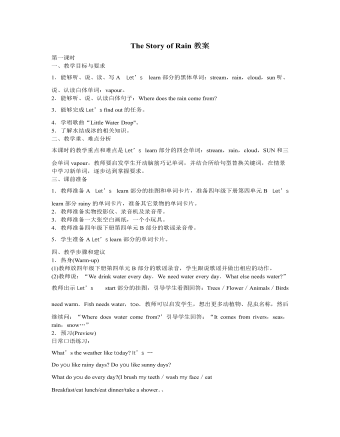
人教版新课标PEP小学英语六年级上册The Story of Rain教案
(2)教师说:“I am going to plant a flower on the weekend.But I don’t know hoⅥ do that.Can you tell me? Who knows?”教师提示学生可以适当用中文解释。如果有学生举手,教师就问:“OK.How d0 you do that?”引导学生回答。“First,put the seeds in the soil.”然后,教师接着说:“What should I do then? 引导学生回答“Water it. (3)教师说:“Zhang Peng is talking to h is teacher.Now Let’s see what they talking about.”学生翻开学生用书,教师放录音,学生跟读。教师解释In several days的意思是几天以后。”教师板书四会句型:How do you do that? What should you do then?学生仿写。 (4)同桌学生进行对话替换操练,可以谈论西瓜(watermelon)、小麦(wheat)等植物的种植过程。然后选几组在班上表演对话。 (5)教师指导学生运用主句型编对话。以下对话供参考: A:How do you clean the classroom? B:First.sweep the floor. A:What should you do after that? B:Then clean the desks and chairs.wash the windows. 4.巩固和延伸(Consolidation and extension) (1)做本单元B Let’s talk部分的活动手册配套练习。
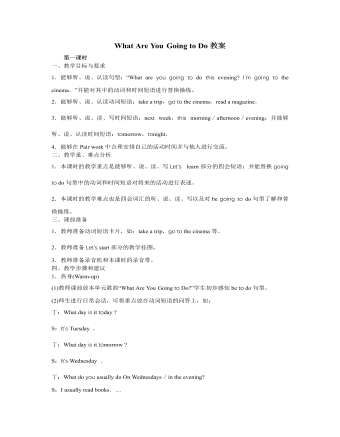
人教版新课标PEP小学英语六年级上册What Are You Going to Do教案
1.热身(Warm-up) (1)全班一起吟唱Let’s chant的歌谣。 (2)单词拼写竞赛 要拼写的单词包括:this morning/afternoon/evening,next week,newspaper, postcard等。可采取小组合作的“接龙式”拼写形式;也可以选取组内一名学生拼写全部单词。拼出单词最快最多的组获胜。 (3)教师出示简明地图,师生问答如下: r:What shop is it? s:It’s a bookstore. r:What can you buy in the bookstore? s:… 在学生回答各商店所出售的物品时,教师根据其回答贴出物品的小卡片,如: Fruit stand:orange,apple,pear,banana….Shoe store:sneakers,sandals,boots….(此时可引导学生说“a pair of sneakers/boots’’等) 2.预习(Preview) Let’s try 教师指着地图中的商店及各商店所出售的物品说:Look!There are so many stores and so many goods.Let’s listen to the tape and find out:①Where is Sarah going? ②What is she going to buy? ③Who is she going with? 教师放三遍Let’s try部分的录音,以上问题可根据学生的实际情况分三次提出,直到多数学生能回答并能将前两项答案填人教师课前画出的表格中。在填表过程中,教师请学生一起拼写其中的四会单词,如:bookstore,comic book。
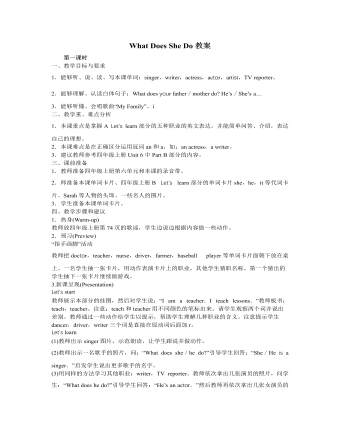
人教版新课标PEP小学英语六年级上册What Does She Do教案
(3)教师就黑板上的内容和学生做对话练习,如:What does your mother do?Where does she work?How does she go to work?教师板书“Where does she work?”和“How does she go to work?”,示范朗读,学生跟说。学生两人一组根据黑板上的语言提示做对话练习。 (4)“看卡片,说句子”活动 教师面前放一摞单词卡片,依次为:职业名称卡片,工作地点卡片和交通方式卡片。活动开始,教师随意从第一摞卡片中抽取一张职业卡片,如:engineer,举起来问:“What does your father do?”学生回答“He’s an engineer.”教师继续抽取一张工作地点卡片,举起来,如:Car company,问:“Where does he work?”学生说:“He works in a Car company.”教师再抽取一张交通方式卡片,如:bus,问:“How does he go to work?学生回答:“He go es to work by bus.”游戏进行几轮后,可以请几名学生轮流代替教师抽卡片,提问题。 (5)教师放本部分的录音,学生跟读。学生两人一组读课文对话。 (6)学生两人一组做对话替换练习。 (7)教师指导学生书写四会句子。 4.巩固和延伸(Consolidation and ex tension) Group work
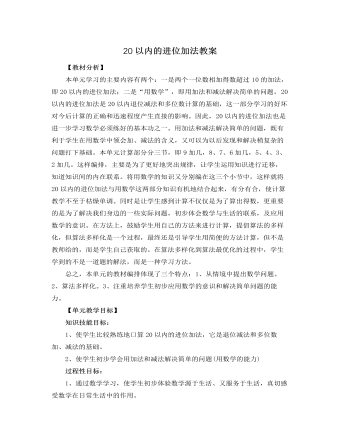
人教版新课标小学数学一年级上册20以内的进位加法教案
教学目标:1、通过多种形式的练习,提高学生的计算速度和正确率。2、培养学生看图表的能力,初步渗透统计思想。3、培养学生学习数学的兴趣,同时培养学生的数感。教学重、难点:熟练掌握计算方法并能够进行正确的计算,能够有效的提高计算速度及正确率教学过程:一、基本练习1、口算10-38+49-1 9-88+215+38+77+55+6 3+911-19+68+86+78+6 9+82+93+102、()里应填什么数?(1)比9大2的数是(),比7多4的数是()。(2)写出得数是13的四道算式?( )、()、( )、()(3)练习9+()=13 8+()=1512-()=2()+7=14()+()=12 ()+()=19二、指导练习练习二十一第4题(1)学生看书,弄清题目的意思。问:这题是什么意思?(2)分组讨论,并派代表说一说。(3)教师板书,引导学生看统计表。指导学生看表:表的第一竖行画有皮球、毽子、跳绳;第二竖行上面写着“一班有”,下面的数就是一班有这三种体育用品的数量,即一班有7个皮球、5个毽子、4条跳绳;
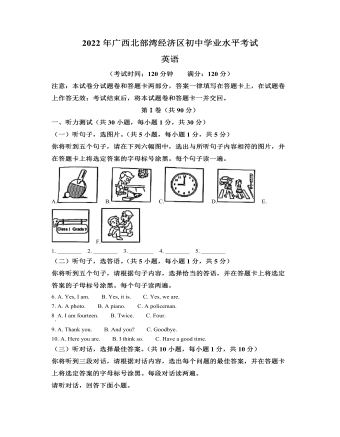
2022年广西北部湾经济区中考英语真题(解析版)
Ibelieved that I was right and he was wrong, and Tony believed that I was wrongand he was right. Our teacher, a kind and smart lady, decided to teach us alesson. She brought us to the front of the class and placed him on one side ofher desk and me on the other. In the middle of her desk was a large and roundobject. I could clearly see that it was black. The teacher asked us what colorthe object was. “White,” Tony answered. I couldn’t believe he said the objectwas white! “Clearly, it was black!” Another argument started between Tony andme, this time about the color of the object.
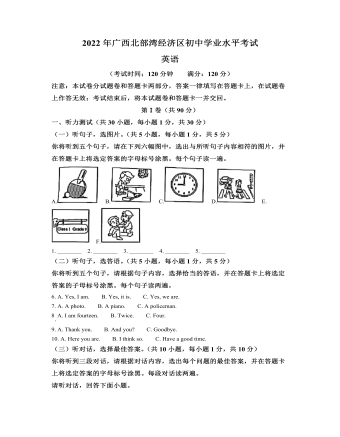
2022年广西北部湾经济区中考英语真题(解析版)
Ibelieved that I was right and he was wrong, and Tony believed that I was wrongand he was right. Our teacher, a kind and smart lady, decided to teach us alesson. She brought us to the front of the class and placed him on one side ofher desk and me on the other. In the middle of her desk was a large and roundobject. I could clearly see that it was black. The teacher asked us what colorthe object was. “White,” Tony answered. I couldn’t believe he said the objectwas white! “Clearly, it was black!” Another argument started between Tony andme, this time about the color of the object.
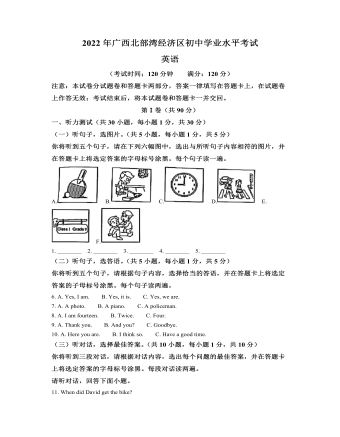
2022年广西北部湾经济区中考英语真题(原卷版)
Ibelieved that I was right and he was wrong, and Tony believed that I was wrongand he was right. Our teacher, a kind and smart lady, decided to teach us alesson. She brought us to the front of the class and placed him on one side ofher desk and me on the other. In the middle of her desk was a large and roundobject. I could clearly see that it was black. The teacher asked us what colorthe object was. “White,” Tony answered. I couldn’t believe he said the object waswhite! “Clearly, it was black!” Another argument started between Tony and me,this time about the color of the object.
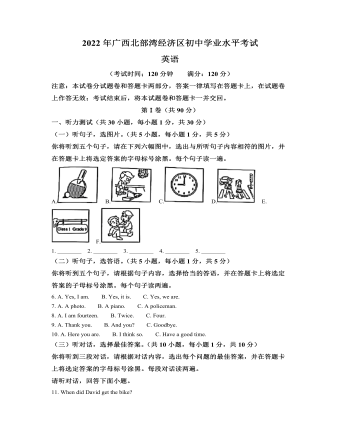
2022年广西北部湾经济区中考英语真题(原卷版)
By usingthis method, the study found that red meats were the most unfriendly foods tothe environment. Keeping farm animals produces a large number of methane(甲烷)that keeps 30 times more heat than CO2. As well asmaking the earth warmer, eating too much red meat is known to increase the riskof a few illnesses, such as heart trouble.
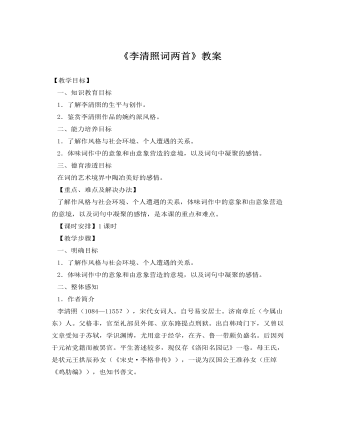
人教版高中语文必修4《李清照词两首》教案
2.【提问】《醉花阴》反映的是早年丈夫赵明诚游宦在外,作者一个人留在家中的生活状况和内心感受。对于这样的“闺怨”题材,应当怎样评价呢?【明确】作者作为一个封建时代的妇女,能够坦率地表达出自己对于丈夫深深的思恋之情,描写了闺中生活的孤独寂寞,这在当时乃是一种很大胆的行为。所以,有人批评说:李清照作词是“无顾忌”地“肆意落笔”。其实,感情的充沛、真挚,敢于正面地展露自己的行为和内心世界,正是她创作成功的重要原因之一,也正是她的词最值得珍视的地方。3.【提问】古人常常爱用花比喻人之美貌,如“芙蓉如面柳如眉”,“人面桃花相映红”等,而李清照却说“人比黄花瘦”,这样的比喻有什么丰富的内涵?【明确】黄色的菊花不止外形上雅淡、清秀,与作者因相思而消瘦的体态相近,而且在菊花品格的传统象征意义上,也酷似作者清高、淡泊的精神,这样的比喻正比较恰切地反映了当时作者由于离开丈夫而孤独、愁闷的生活状态和内心情感。
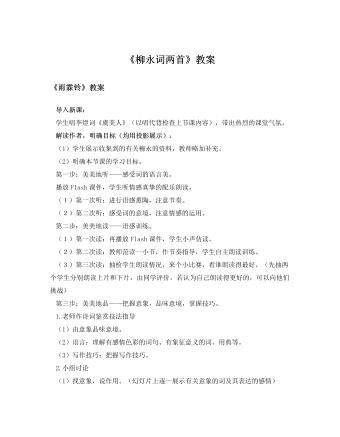
人教版高中语文必修4《柳永词两首》教案
(一)上片:描写杭州的自然风光和都市的繁华“东南形胜,三吴都会,钱塘自古繁华”,“东南形胜”,是从地理条件、自然条件着笔写的。杭州地处东南,地理位置很重要,风景很优美,故曰:“形胜”。“三吴都会”,是从社会条件着笔写的。它是三吴地区的重要都市,那里人众荟萃,财货聚集,故曰:“都会”。“钱塘自古繁华”,这一句是对前两句的总结,因为杭州具有这些特殊条件,所以“自古繁华”。下面就对“形胜”、“都会”和“自古繁华”进行铺叙。“烟柳画桥,风帘翠幕,参差十万人家”是对“三吴都会”的展开描写。“云树绕堤沙。怒涛卷霜雪,天堑无涯”是对“东南形胜”的展开描写。这里选择了钱塘江岸和江潮两种景物来写。“市列珠玑,户盈罗绮,竞豪奢”是对“钱塘自古繁华”的展开描写。描写了两个方面:一是商业贸易情况——“市列珠玑”,只用市场上的珍宝,代表了商业的丰富、商业的繁荣;二是衣着情况——“户盈罗绮”,家家披罗着锦。“竞豪奢”,又总括杭州的种种繁华景象。
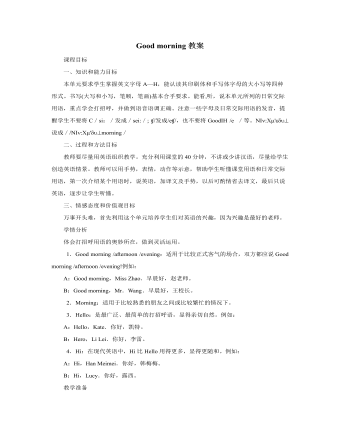
人教版新目标初中英语七年级上册Good morning教案
一、知识和能力目标本单元要求学生掌握英文字母A—H,能认读其印刷体和手写体字母的大小写等四种形式。书写(大写和小写,笔顺,笔画)基本合乎要求。能看,听,说本单元所列的日常交际用语,重点学会打招呼,并做到语音语调正确。注意一些字母及日常交际用语的发音,提醒学生不要将C/si:/发成/sei:/; ?/发成/e?/,也不要将Good?H /e /等。??????'????说成/???????'???morning/二、过程和方法目标教师要尽量用英语组织教学。充分利用课堂的40分钟,不讲或少讲汉语,尽量给学生创造英语情景。教师可以用手势,表情,动作等示意,帮助学生听懂课堂用语和日常交际用语,第一次介绍某个用语时,说英语,加译文及手势,以后可酌情省去译文,最后只说英语,逐步让学生听懂。
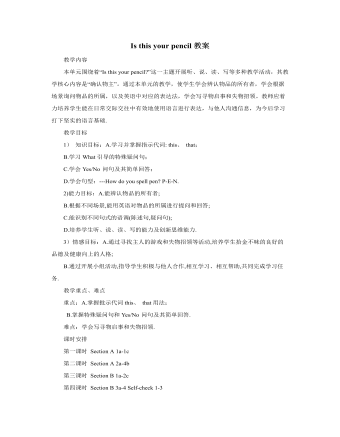
人教版新目标初中英语七年级上册Is this your pencil教案
T: Please look at the pictures and learn the new words.(用多媒体展示新单词效果较好。)1.at prep. 在(里面或附近);在(点刻);2.theart.表示特指的人、物、事或群体 3.lostadj.丢失的;遗失的4.Found adj. (find的过去式、过去分词)找回的5.lost and found 失物招领6.please adv.请7.school n. 学校8.a set of一套;一副(Teach students to read the words.)2. Practice the new words. (事先录制一段短的听力,让学生通过听的训练来强化所学的新单词,并为学习写寻物启示和失物招领作好准备。)T: Please listen to a short passage twice then fill the blanks using the words we learned.(Show students a short passage and play the recording for the students to listen.)There are many things in (1)_____________________in my (2)__________. Look, here’s (3)_________keys. Is this yours? (4)__________call Jim (5)___________753-2289.Typescript:There are many things in the Lost and Found in my school. Look, here’s a set of keys. Is this yours? Please call Jim at 753-2289.
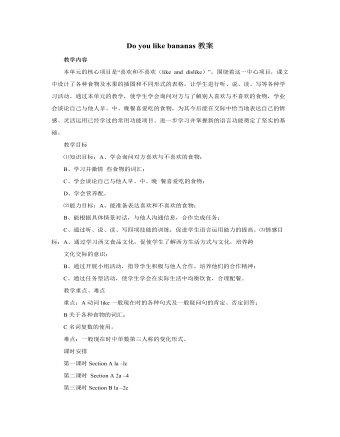
人教版新目标初中英语七年级上册Do you like bananas教案
教学目标 ⑴知识目标:A、学会询问对方喜欢与不喜欢的食物; B、学习并激情 些食物的词汇; C、学会谈论自己与他人早、中、晚 餐喜爱吃的食物; D、学会营养配。 ⑵能力目标:A、能准备表达喜欢和不喜欢的食物; B、能根据具体情景对话,与他人沟通信息,合作完成任务; C、通过听、说、读、写四项技能的训练,促进学生语言运用能力的提高。⑶情感目标:A、通过学习西文食品文化,促使学生了解西方生活方式与文化,培养跨 文化交际的意识; B、通过开展小组活动,指导学生积极与他人合作,培养他们的合作精神; C、通过任务型活动,使学生学会在实际生活中均衡饮食,合理配餐。 教学重点、难点 重点:A动词like一般现在时的各种句式及一般疑问句的肯定、否定回答; B关于各种食物的词汇; C名词复数的使用。 难点:一般现在时中单数第三人称的变化形式。